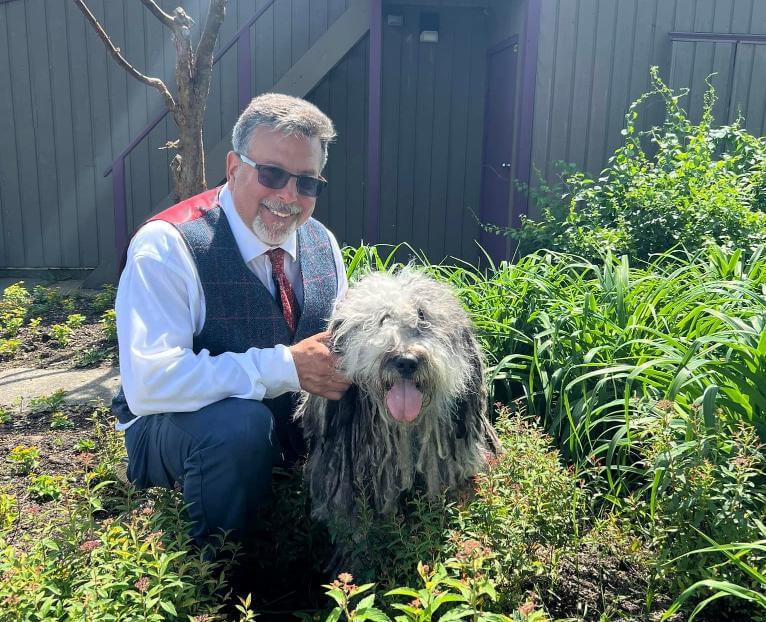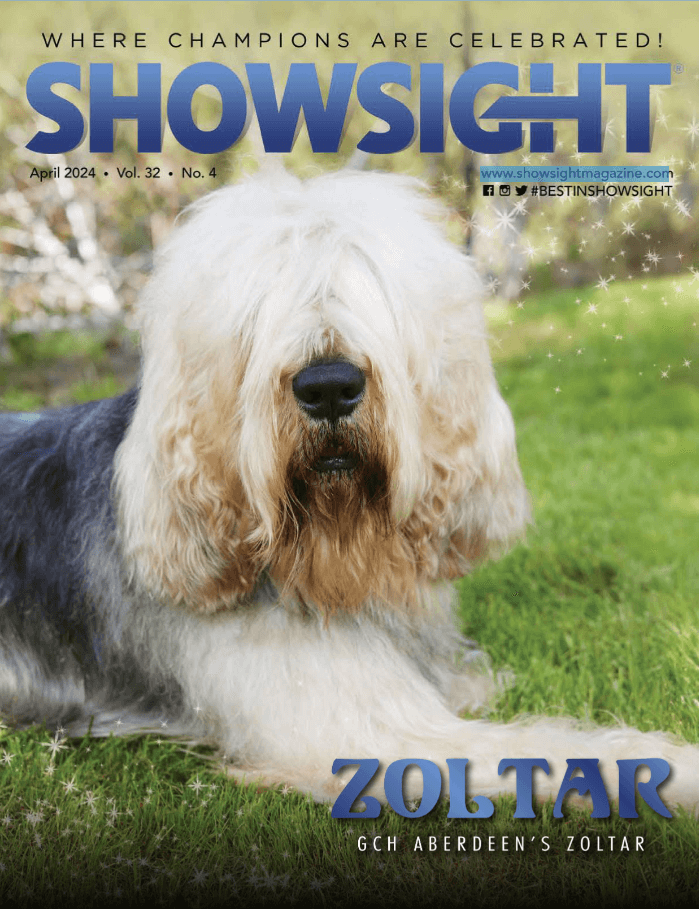Since I took on the mission of writing on the psychology of dog shows, I have thrust myself into the peer reviewed publications that discuss the scientific study of human and dog behavior that are relatable to conformation shows. What I have discovered is that there is a plethora of research that delves into many areas of dog personality and behavior that speaks to the unique human-canine relationship that defines our experiences as enthusiasts, owners, handlers, groomers, etc. What makes the dog-human connection so interesting to explore is the fact that both humans and dogs are “social species” whose behaviors are shaped by their biology, psychology, and social interactions over the course of their development. Since man has been domesticating dogs for 14,000 years, making dogs an extension of human capacity, the dog has developed personalities that mirror their masters.
In my article, published in the May 2022 edition of Showsight, I discussed the Big 5 Personality Test and its relationship to human personality and how we react to competition. When I was researching dog personality, I discovered something remarkable: dogs share the same five measurable areas of personality with their human counterparts. From an evolutionary standpoint, two species that have strong social inclinations and coexist in a reciprocal relationship for a long period of time will share traits that make their relationship positive and rewarding. Dogs being man’s best friend is not an accidental occurrence. It is an evolutionary reality that plays out in our very real relationships with our canine partners.
Dog Personality Questionnaire
The DPQ, Dog Personality Questionnaire, was developed by researchers at The University of Texas. It tests five areas of dog personality in the same manner that The Big 5 tests people.
There is a direct parallel to the traits measured by the DPQ and those measured in humans with the Big 5. Fearfulness could be the dog equivalent of openness to experience, and the same goes for the rest of the traits that are paralleled in the Big 5. (See table below.) DPQ was developed by the Department of Psychology at the University of Texas and has been extensively tested to show its psychometric validity.
Factors Tested in The Human Version of The Big 5 Personality Test
- Factor 1 – Openness to Experience (inventive/curious vs. consistent/cautious);
- Factor 2 – Conscientiousness (efficient/organized vs. easy-going/careless);
- Factor 3 – Extraversion (outgoing/energetic vs. solitary/reserved);
- Factor 4 – Agreeableness (friendly/compassionate vs. critical/rational);
- Factor 5 – Neuroticism (sensitive/nervous vs. resilient/confident)[2].
Factors Tested in Dog Personality Test
- Factor 1 – Fearfulness;
- Factor 2 – Aggression Towards People;
- Factor 3 – Activity/Excitability;
- Factor 4 – Responsiveness to Training;
- Factor 5 – Aggression Towards Animals.
Since psychometric testing is the only objective way in which we can measure psychological traits in an individual person or, in this case, dogs, I thought it would be fun to learn more about how my dog’s personality and how she compares to the rest of the canine population. I downloaded a hard copy of the DPQ and completed the test with one of my American Staffordshire Terriers. “Lily” is a four-year-old bitch who is the alpha in my household as well as my closest canine partner. Keep in mind that when you are completing a test for a non-verbal subject, it is important to be as objective as possible and not bias your scoring due to your feelings about the subject. According to the American Kennel Club, these dogs are “smart, confident, good-natured companions. Their courage is proverbial. A responsibly bred, well-socialized AmStaff is a loyal, trustworthy friend to the end.”
If you decide to take the test with your dog, the “mean” displayed below is for the long version of the test. The mean is the average score for the total population surveyed. Scores lower than the mean indicate your dog displays less of the characteristic, and scores higher than the mean indicate that your dog displays more of the characteristic. If you need help scoring this test, post your question on my dedicated Facebook page www.facebook.com/groups/dogshowpsychology/ or reach out on Facebook Messenger. You will also find my previous articles as well as links to test for both human and dog personality tests, and other dog-related articles that are relevant to individuals who show dogs.
Personality and Behavior of a Dog – Talking to Lily
I have owned American Staffordshire Terriers since 1979. My parents bred and showed Standard Poodles, and my father wanted to find another breed that did not have the grooming requirements and that we could show ourselves. While I did have fun running around the ring with Wendell Sammet, Richard Bauer, and Paul Edwards, it was hard to get “a piece” of the breed. From a personality perspective, I was attracted to the way AmStaffs connect to their people. When your AmStaff loves you, they provide you with an excess of affection and are driven to be by your side all the time. Lily is no exception. If I am in the house, she is usually within arm’s reach. If I get up, she gets up. When we are out in public, Lily wants to meet and greet every human who is in her presence. Lily plays the role of ultimate breed ambassador at indoor shows, as she will find people and show some warmth and loving. Since most of us are caught up in doing the work of prepping and showing our dogs, Lily entertains spectators with her warmth and exuberance. She really adores children and is gentle with them. At the Philadelphia Kennel Club show, Lily’s demeanor landed her on the opening video, entertaining people by doing her best ballet impression—and she smooched 1,500 kids!
Lily’s test results really do correlate to her behavior:
Factor 1 – Fearfulness: Lily scored 29, with an average of 116 for all dogs. One can easily derive that Lily does not express much fear, regardless of the situation. In AmStaffs, this is something that appears to be hard-wired and a product of selective breeding.
Factor 2 – Aggression Towards People: Once again, Lily scores an extremely low 14, with the average for all dogs being 56. Much of the historical literature on the breed speaks about the breed having natural bite-inhibition with people. While we have all heard the horror stories of Pitbulls biting people, this only happens when the dog is psychologically damaged by their owners. My first AmStaff, “Missy,” was a guest on “Nightline” in 1986, sitting with Roger Karas, who wrote books on dogs and was the announcer for the Westminster Kennel Club Dog Show, to discuss how the breed had been wrongly singled out as a killer dog.
Factor 3 – Activity/Excitability: Lily scored slightly higher than average, 112, with the average being 100. AmStaffs are really like their Terrier relatives. They can be busy and they love stimulation. Lily is no exception! She can play catch for hours on end, and my friends have said that she swallowed the “Energizer Bunny.”
Factor 4 – Responsiveness to Training: Lily scored a very average 48, with an average of 40. Lily is a good learner and can be a people pleaser, but she also likes to show that she has a mind of her own. I wouldn’t say that Lily is the easiest to train or the most eager learner, but this also might be my influence as I just expect her to listen and do as she is told… which she does.
Factor 5 – Aggression Towards Animals: Lily scored 46, with an average score of 60.
While Lily’s test score is below the mean, anyone who is a responsible owner of an AmStaff knows the mantra, “Never trust an AmStaff not to fight.” Lily is never looking for a fight, but I know that if she were challenged by an aggressive dog, she would respond in kind. She has many doggie friends, including a few Tibetan Spaniels that she finds amusing, but I am cautious with other dogs that I do not know. The biggest take-away from this statement is, regardless of how well you know your dog, you need to be aware of situations that might provoke an unexpected response. Early in my ownership of AmStaffs, while my parents were breeding and showing Standard Poodles, I recall being under the grooming tent with AmStaffs and Poodles on grooming tables. Fearfully, people would walk around the AmStaffs only to be greeted by the touch from a 27.5-inch male Poodle who didn’t care for other intact male dogs. For the most part, the Amstaffs could’ve cared less.
Personality and Behavior of a Dog – Conclusion
While personality tests provide a novel approach that can help you to understand your dog’s personality vs. the rest of the canine population, there are several discussions that we can undertake using personality as a starting point. The first thing that comes to mind is whether the breed that you have selected is well-suited to your personality. Having been around dog shows for most of my life, I have seen numerous people struggling with their breed of choice. I wonder if they didn’t do enough research about the breed and its personality.
Another area that I will discuss in future articles relating to personality is how the way in which we raise our dogs affects their behaviors and how we can learn to be better doggie parents.
| Lily’s Results |
| Factor |
Raw Score |
Mean |
|
| Factor 1 – Fearfulness |
29 |
116 |
Extremely Low |
| Factor 2 – Agression towards People |
14 |
56 |
Extremely Low |
| Factor 3 – Activity/Excitability |
112 |
100 |
Slightly above average |
| Factor 4 – Responsiveness to training |
48 |
40 |
Slightly above average |
| Factor 5 – Agression towards Animals |
46 |
60 |
Moderately below average |








